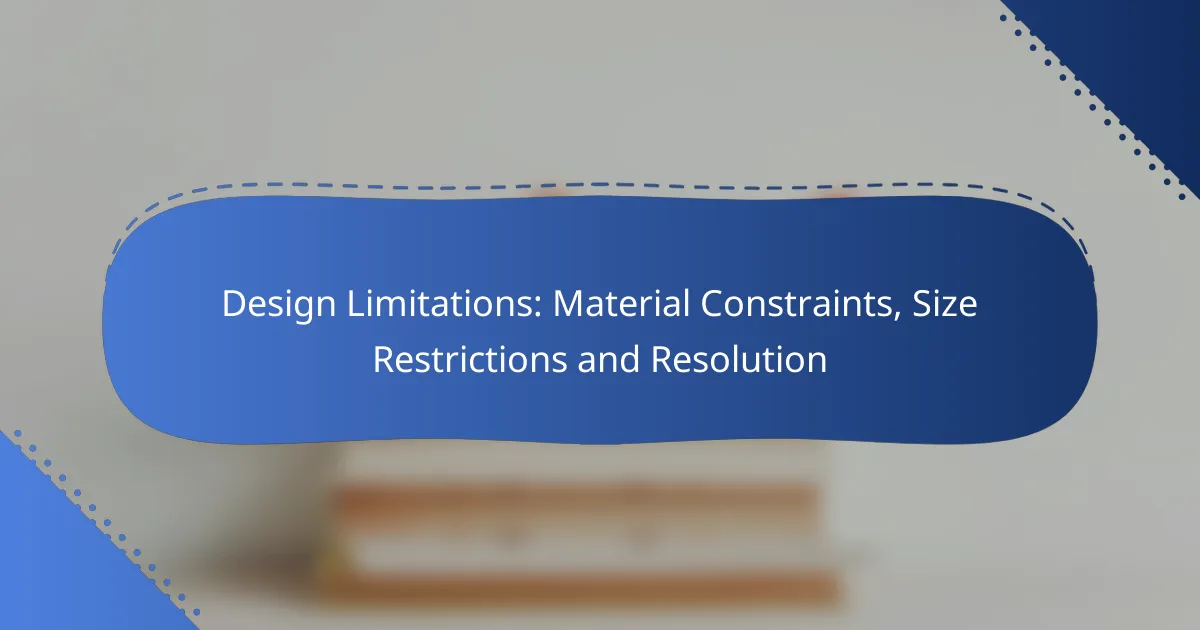Design limitations are critical factors that shape the effectiveness and feasibility of any project. Material constraints, size restrictions, and resolution considerations play pivotal roles in determining the strength, functionality, and visual clarity of a design. Understanding these limitations allows designers to create solutions that are both innovative and practical, ensuring that the final product meets user needs and expectations.

What are the design limitations in materials?
Design limitations in materials encompass factors such as material strength, durability, cost, and environmental impact. Each of these aspects can significantly influence the feasibility and effectiveness of a design project.
Material strength
Material strength refers to the ability of a material to withstand applied forces without failure. Designers must consider tensile strength, compressive strength, and shear strength when selecting materials for their projects. For instance, metals like steel offer high tensile strength, making them suitable for structural applications, while plastics may be chosen for lightweight designs despite lower strength.
Durability factors
Durability factors include resistance to wear, corrosion, and environmental conditions. Materials that are durable can extend the lifespan of a product, reducing the need for replacements. For example, stainless steel is often preferred for outdoor furniture due to its resistance to rust, while untreated wood may deteriorate quickly when exposed to moisture.
Cost implications
The cost of materials can vary widely based on availability, quality, and market demand. Designers should balance the desired properties of materials with budget constraints. For instance, while high-performance composites may offer superior strength-to-weight ratios, they often come at a premium price compared to traditional materials like aluminum or wood.
Environmental impact
Environmental impact involves the sustainability of material sourcing, production processes, and end-of-life disposal. Designers are increasingly prioritizing eco-friendly materials, such as recycled plastics or sustainably sourced timber, to minimize their carbon footprint. Additionally, understanding local regulations regarding material use can guide choices that align with environmental standards.

How do size restrictions affect design?
Size restrictions significantly influence design by limiting the dimensions and proportions of a product or space. Designers must carefully consider these constraints to ensure functionality, aesthetics, and user experience align with the intended purpose.
Physical dimensions
Physical dimensions refer to the actual measurements of a design, including height, width, and depth. These constraints can dictate the materials used, the complexity of the design, and the feasibility of manufacturing. For example, a product intended for handheld use must be compact enough to fit comfortably in a user’s hand, typically within a range of 10 to 20 centimeters in length.
Designers should always verify the physical dimensions against user needs and ergonomic standards. Ignoring these factors can lead to products that are uncomfortable or impractical, ultimately affecting user satisfaction and market success.
Space constraints
Space constraints involve the limitations imposed by the environment where a design will be implemented. This can include the available area for installation, storage, or movement. For instance, furniture designed for small apartments must maximize utility while minimizing footprint, often requiring innovative designs that serve multiple functions.
When addressing space constraints, designers should consider modular designs or collapsible features that allow for flexibility. A common pitfall is underestimating the importance of clearances and access routes, which can lead to designs that are difficult to use or install.
Prototyping challenges
Prototyping challenges arise from the need to create functional models that accurately reflect the final design within size restrictions. These challenges can include sourcing materials that meet both aesthetic and functional criteria while adhering to dimensional limits. Rapid prototyping technologies can help, but they often come with their own set of limitations regarding size and material properties.
To navigate prototyping challenges effectively, designers should prioritize iterative testing and feedback. This process allows for adjustments based on real-world performance, ensuring that the final product meets both design intentions and user needs while staying within size constraints.

What is the impact of resolution on design?
Resolution significantly affects design by determining the clarity and detail of images and graphics. Higher resolution results in sharper visuals, while lower resolution can lead to pixelation and loss of quality, impacting user experience and aesthetic appeal.
Pixel density
Pixel density, measured in pixels per inch (PPI), indicates how many pixels are packed into a given area. Higher pixel density means more detail and smoother edges in images, which is crucial for high-quality designs. For instance, a display with 300 PPI will render text and graphics much more crisply than one with 72 PPI.
When designing for various devices, consider the target pixel density. Mobile devices often require higher PPI for clarity, while larger screens may allow for lower densities without compromising quality.
Print vs. digital resolution
Print resolution is typically measured in dots per inch (DPI) and usually requires higher values, often around 300 DPI for quality prints. In contrast, digital resolution can vary widely, with common standards being 72 PPI for web images and up to 300 PPI for high-resolution displays.
Designers must adjust their files based on the medium. For print, ensure images are created at a higher resolution to avoid blurriness, while for digital formats, optimizing file size without sacrificing quality is key.
Display technology
Different display technologies, such as LCD, OLED, and LED, can influence how resolution is perceived. OLED displays often provide better contrast and color accuracy, enhancing the impact of high-resolution designs. In contrast, older LCD technologies may not display colors as vividly, even at high resolutions.
When designing for specific display technologies, consider the capabilities and limitations of each. For example, designs for OLED screens can leverage deeper blacks and vibrant colors, while those for standard LCDs may need adjustments to maintain visual appeal.

What are the best practices for overcoming material constraints?
To effectively overcome material constraints in design, focus on selecting appropriate materials and employing innovative techniques that align with project goals. Understanding the properties of materials and their limitations can lead to better design outcomes.
Material selection strategies
Choosing the right materials is crucial for addressing design limitations. Consider factors such as strength, weight, cost, and environmental impact. For instance, lightweight composites may be ideal for aerospace applications, while durable metals are better suited for construction.
Evaluate materials based on their performance in specific conditions. For example, if a product will be exposed to moisture, opt for corrosion-resistant materials. Always balance cost and performance to ensure the selected material meets both budgetary and functional requirements.
Innovative design techniques
Utilizing innovative design techniques can help mitigate material constraints. Techniques like parametric design allow for the exploration of multiple configurations and material uses, optimizing performance while minimizing waste. This approach is particularly beneficial in industries like automotive and architecture.
Consider additive manufacturing, or 3D printing, which enables the creation of complex geometries that traditional methods cannot achieve. This technology can reduce material usage and lead to lighter, more efficient designs. Always stay updated on emerging technologies that can enhance material efficiency and design flexibility.

What criteria should be considered for size restrictions?
Size restrictions are influenced by factors such as the intended use of the design, user ergonomics, and material properties. Understanding these criteria helps ensure that the final product meets both functional and aesthetic requirements.
Target audience needs
When considering size restrictions, it’s crucial to evaluate the needs of the target audience. This includes understanding their physical capabilities, preferences, and the context in which they will use the product. For example, a product designed for children may need to be smaller and lighter than one intended for adults.
Gathering feedback through user testing can provide insights into how size affects usability and satisfaction. This feedback can guide adjustments to dimensions that enhance comfort and accessibility.
Regulatory compliance
Regulatory compliance often dictates specific size restrictions, especially in industries such as healthcare, automotive, and consumer electronics. These regulations ensure safety and functionality, requiring adherence to established standards for dimensions and ergonomics.
For instance, medical devices must comply with guidelines that specify minimum and maximum sizes to ensure they can be safely handled by users. Familiarizing yourself with relevant regulations early in the design process can prevent costly redesigns and ensure market readiness.

How can resolution challenges be addressed in design?
Resolution challenges in design can be tackled by employing adaptive design methods and utilizing high-resolution assets. These strategies ensure that visuals remain sharp and clear across various devices and formats, enhancing user experience.
Adaptive design methods
Adaptive design methods involve creating layouts that adjust to different screen sizes and resolutions. This approach ensures that content is displayed optimally, regardless of the device used, whether it’s a smartphone, tablet, or desktop.
Key techniques include using flexible grids, fluid images, and media queries to tailor the design. For instance, a website might display a single-column layout on mobile devices while switching to a multi-column layout on larger screens.
When implementing adaptive design, consider the trade-offs between performance and visual fidelity. Testing across various devices is crucial to ensure a seamless experience for all users.
High-resolution assets
High-resolution assets are essential for maintaining clarity in design, especially on devices with high pixel density. Utilizing images and graphics that are at least double the target resolution can prevent blurriness and pixelation.
For example, if designing for a display that requires 300 DPI, assets should be created at 600 DPI. This practice is particularly important for print materials and high-quality digital displays.
To optimize loading times, consider using formats like SVG for logos and icons, which scale without losing quality. Additionally, implement lazy loading techniques to enhance performance without sacrificing image quality.

What emerging trends are shaping design limitations?
Emerging trends in technology, sustainability, and user experience are significantly influencing design limitations. Designers must navigate material constraints, size restrictions, and resolution challenges while adapting to these evolving demands.
Material Constraints
Material constraints refer to the limitations imposed by the properties and availability of materials used in design. For instance, the choice of sustainable materials may limit options for durability or flexibility, affecting the overall design outcome. Designers should consider the environmental impact and performance characteristics of materials to ensure they meet both aesthetic and functional requirements.
Common materials like plastics, metals, and composites each have unique properties that can restrict design possibilities. For example, while metals offer strength, they may not be suitable for lightweight applications. Understanding the trade-offs between different materials is crucial for effective design.
Size Restrictions
Size restrictions are often dictated by practical considerations such as space, ergonomics, and usability. Designers must account for the physical dimensions of products to ensure they fit within designated environments, whether that be a compact urban apartment or a large commercial space. Adhering to size limitations can enhance user experience and functionality.
For example, in furniture design, a chair must not only be aesthetically pleasing but also fit comfortably within a room’s layout. Designers can use tools like 3D modeling to visualize how size impacts the overall design and make necessary adjustments early in the process.
Resolution Challenges
Resolution challenges arise primarily in digital design, where screen resolution affects the clarity and quality of visual elements. Higher resolutions can enhance user experience by providing sharper images and text, but they also require more processing power and can increase load times. Designers must balance visual fidelity with performance considerations.
When designing for various devices, such as smartphones and tablets, it’s essential to consider the resolution capabilities of each platform. A common practice is to use responsive design techniques to ensure that graphics and layouts adapt seamlessly across different screen sizes and resolutions.
